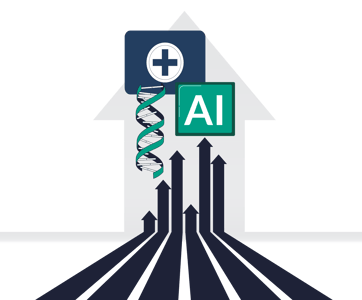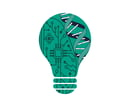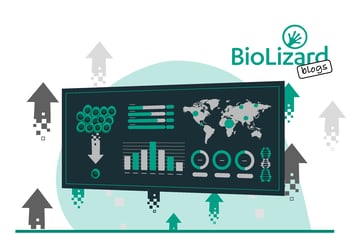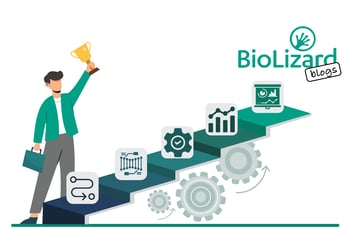Strategic AI for single cell sequencing & multi-omics advances
As we covered in our recent blog series, we expect advances in single cell sequencing to have an important impact on biomedicine. We predict that new technologies and tools like high-throughput single cell sequencing, spatial technologies, and increased public availability of data atlases will bring benefits such as improved personalised medicine and faster drug development.
We also predict that leveraging another high-tech tool - artificial intelligence (AI) - in combination with these new developments in single cell sequencing, and mediated by the increased large volumes of available data, will help us to use them to their full potential. When used well, AI can help us to make better decisions early on in drug discovery pipelines, supporting patient stratification, enabling companion diagnostics, or designing better therapeutics - ultimately improving our chances of making a true impact in medicine.
AI is already making its mark in single cell sequencing
AI is no longer a futuristic technology. Tools like the large language models (LLMs) made famous by ChatGPT are already seeping into single cell analysis, and they are here to stay.
For example, when performing a single cell experiment, you’ll start out with a great number of different cells and cell types. To understand which cells are present, you need a combination of deep domain expertise and robust analytical tools in order to annotate each cell, and to identify interesting outlier cells. Today, LLMs can already act as a sort of “expert robot” that takes a first look through your gene panel (and through existing literature), and then automatically provides suggestions regarding which cell types are present in your data.
This approach has already been demonstrated to work quite well - but note that it’s not (yet) at the point of completely replacing human expertise. It’s still important to complement these capabilities of AIs like large language models with human experts who have a robust background in biology. In other words, in the field of biology, AI doesn’t replace humans: it acts as a helping hand to sift through complex data landscapes with high-dimensionality, as is definitely the case with single cell sequencing datasets.
 Alongside these handy, helpful LLMs, perturbation models - a type of predictive modelling - are another form of AI that has potential in the field of single cell sequencing. Currently, scientists are actively working on building computational frameworks referred to as perturbation models to predict functional consequences of different treatments - such as drug response. The (somewhat futuristic) idea is that eventually, by intelligently measuring the impact of knocking down genes at different degrees, or combinations of gene knockdowns, we will be able to predict unseen combinatory effects and measure different impacts on disease. This will enabling better selection of potential (combinatory) drug candidates. In the long term, such models could reduce the amount of wet-lab, preclinical experimentation needed to come up with a successful drug candidate and would enable precision medicine, by measuring treatment effects per disease subtype or even at individual patient level.
Alongside these handy, helpful LLMs, perturbation models - a type of predictive modelling - are another form of AI that has potential in the field of single cell sequencing. Currently, scientists are actively working on building computational frameworks referred to as perturbation models to predict functional consequences of different treatments - such as drug response. The (somewhat futuristic) idea is that eventually, by intelligently measuring the impact of knocking down genes at different degrees, or combinations of gene knockdowns, we will be able to predict unseen combinatory effects and measure different impacts on disease. This will enabling better selection of potential (combinatory) drug candidates. In the long term, such models could reduce the amount of wet-lab, preclinical experimentation needed to come up with a successful drug candidate and would enable precision medicine, by measuring treatment effects per disease subtype or even at individual patient level.
Similarly, by leveraging these high-throughput deep screenings, deep modelling of disease states becomes possible provided that there is sufficient data. For example, creating so-called “digital twins” can become a possibility in the near future - allowing scientists to experiment with disease states in silico, and identify novel and specific therapeutics on a much larger and faster scale than is possible when relying purely on (wet lab) experiments. Exciting times are ahead!
Strength in numbers: from high-dimensional multi-omics data to better biomedicine
As we’ve covered in previous blog articles, we predict that multi-omics analysis will become increasingly important in the future of biomedical research. That includes the integration of different types of omics data at the single cell level.
For example, imagine that your aim is to detect a given disease as early as possible. In your disease of interest, early diagnosis generally leads to a better prognosis… But it’s difficult to find diagnostic biomarkers that are both consistent across the broad heterogeneity of the human population, and provide useful information about the disease subtype that is (or is not) present - which would inform your subsequent treatment plan.
It might be that you would need a combination of different biomarkers to extract the right information - for instance a cell surface protein combined with a specific transcript - both which are only present in certain subsets of cells. You can see how multi-omics data at the granularity of single cell resolution would come in handy in this example.
The challenge, of course, is that collecting multi-omics data at the single cell level will result in vast amounts of data resources that would be difficult if not impossible to deal with manually. AI has already become an important tool in sifting through this type of highly granular data - and AI shines its brightest when distilling patterns from high dimensional, big data.
From AI dreams to biomedical reality
Even when you leverage AI, the integration of complex (multi-)omics datasets is a challenge. And to address this challenge, we believe that AI alone won’t cut it - it’s also necessary to draw on the expertise of humans for data exploration and interpretation. To support this synergy of computational power with human prowess, user-friendly, interactive tools that allow experts like biologists or physicians to extract data-driven insights - without requiring data science skills - are a must.
BioLizard’s answer to this is Bio|Mx: a pioneering multi-omics integration and analysis application that is specifically engineered to help you decipher the complex data landscape in multi-omics studies. This AI-driven application is designed to automate computational aspects of multi-omics data analysis while keeping you - the human expert - in the loop for critical decision-making. Importantly, like all applications within our Bio|Verse framework, this Bio|Mx is fully customizable, in recognition of the fact that different biological use cases require tailored analytical solutions.




